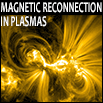Speaker
Dr
Narita Yasuhito
(Austrian Academy of Sciences)
Description
A wave-driven scenario of magnetic reconnection is
presented, the whistler-wave hypothesis, to
explain the triggering mechanism of the reconnection in
space and astrophysical plasmas.
Magnetic reconnection releases a huge amount of energy on
a short time scale, and is believed
to be in operation in the phenomena of auroral substorms,
flares, and coronal mass ejections.
The hypothesis is motivated by the recent reports on the
whistler wave emission from the
reconnecting region both from the observation (Eastwood et
al., Phys. Rev. Lett. 102, 035001,
2009) and from the particle-in-cell simulation (Goldman et
al., Phys. Rev. Lett., 112, 145002,
2014). The whistler waves in our hypothesis are regarded as
a precursor of the reconnection,
and play a central role in the reconnection as sketched by the
following scenario: (1) Whistler
waves are excited prior to the reconnection onset by a
macro- or micro-instability due to the
enhanced inhomogeneity or the presence of non-thermal
components, respectively; (2) The
whistler waves in turn scatter particles (e.g., pitch-angle
scattering), particularly in favor of
electron scattering, and re-distribute the free energy back to
the particle thermal population; (3)
The wave-particle scattering is so effective that it contributes
to a substantial amount of
anomalous resistivity; (4) The electric field of the resistivity
origin is strong enough to violate
the frozen-in condition for the magnetic field on the electron
gyro-scale (cf. the generalized
Ohm's law); (5) And finally, the reconnection sets on, and
remaining whistler waves escape,
carrying the energy away from the reconnecting site. The
central question in the study of the
reconnection under the whistler-wave hypothesis is the
causality, that is, if the wave triggers
the reconnection, or vice versa. According to the hypothesis,
the predictability of the
reconnection depends on the detailed knowledge on the
condition under which the whistler
waves are excited and scatter the particles effectively.
The heliospheric plasma group at Space Research Institute in
Graz, Austria, is now working on
the whistler-wave hypothesis with two independent (but
complementary) approaches: analysis
of spacecraft data for the Cluster and MMS missions and
particle-in-cell simulations. We report
our recent results on the causality between the waves and
the reconnection, the wave
dispersion relations, the four-dimensional energy spectra in
the Fourier domain (spanning the
wavevectors and the frequencies), and the velocity
distribution functions.
Primary author
Dr
Narita Yasuhito
(Austrian Academy of Sciences)
Co-author
P.A. Bourdin
(Austrian Academy of Sciences)

